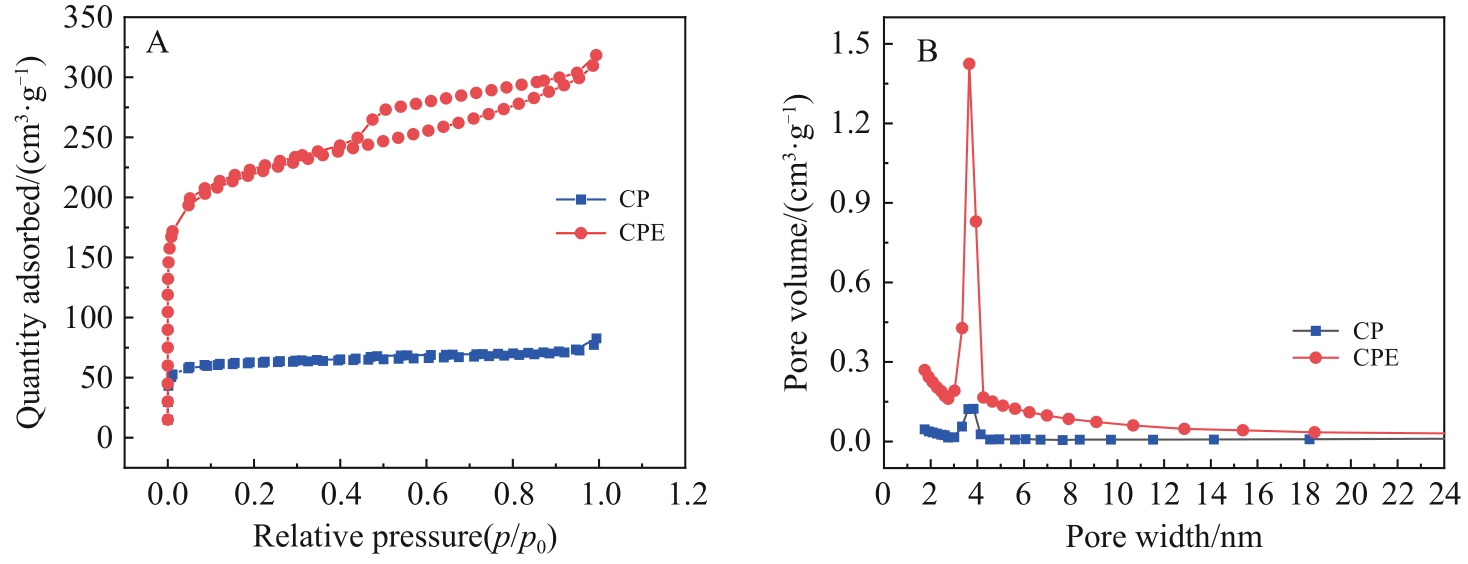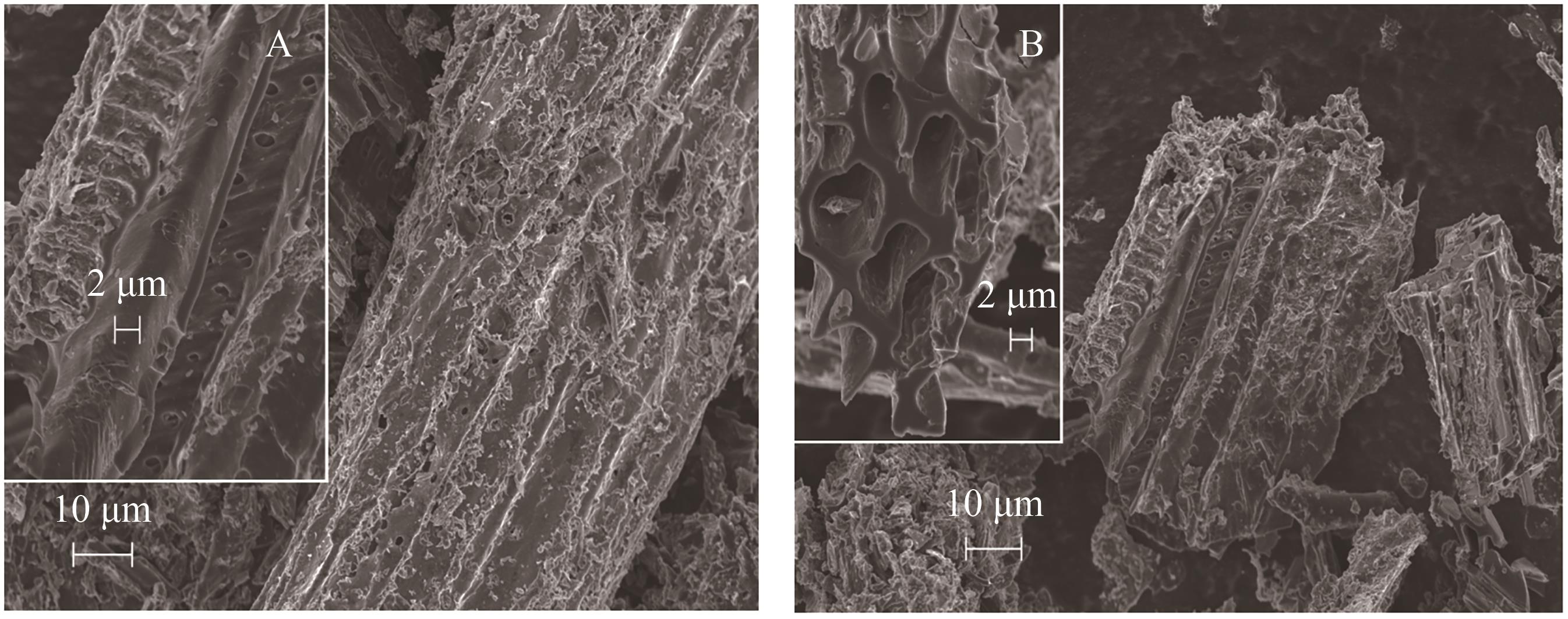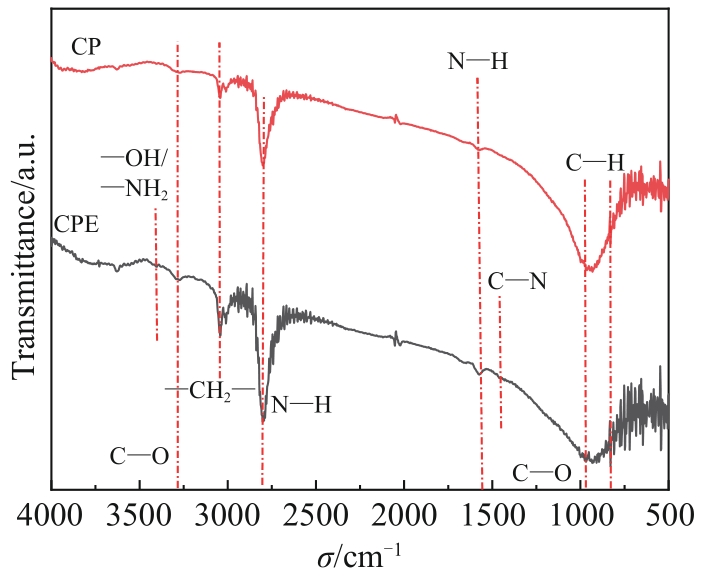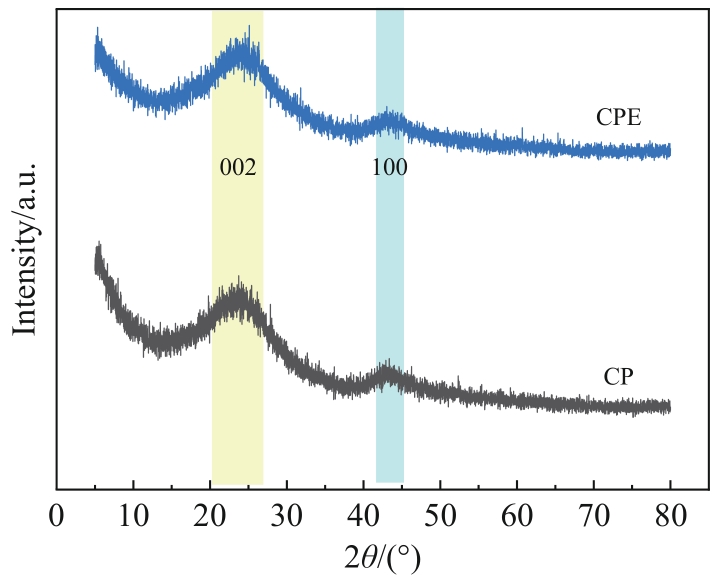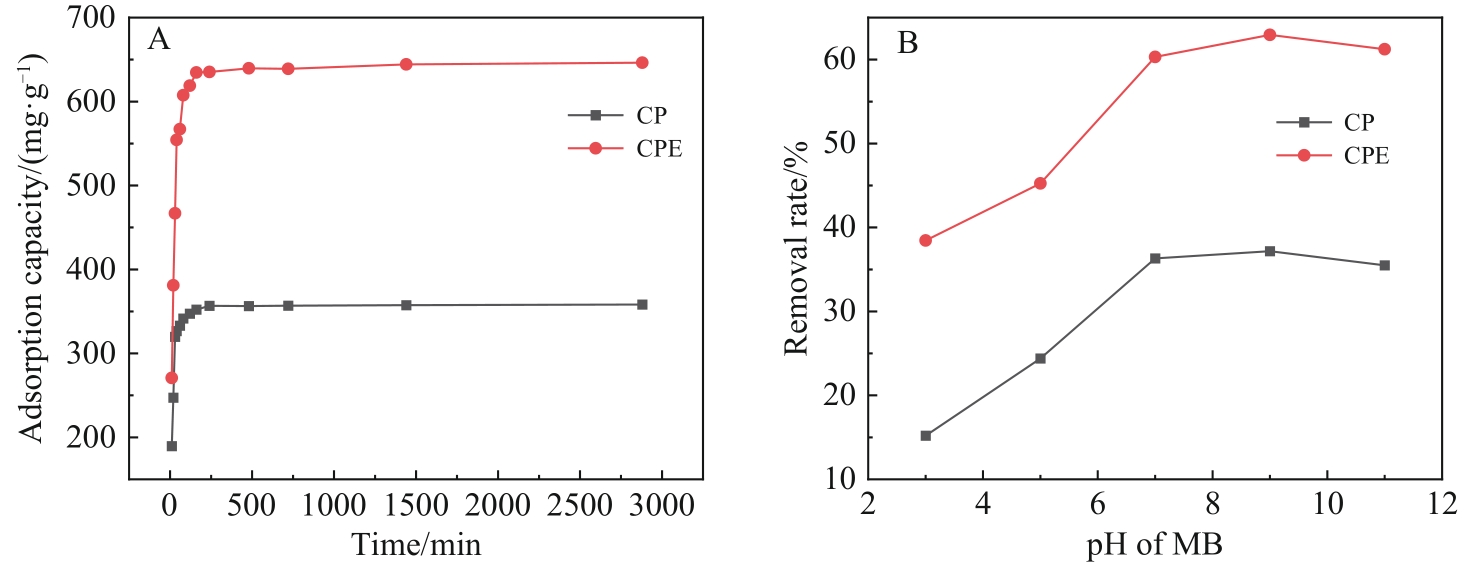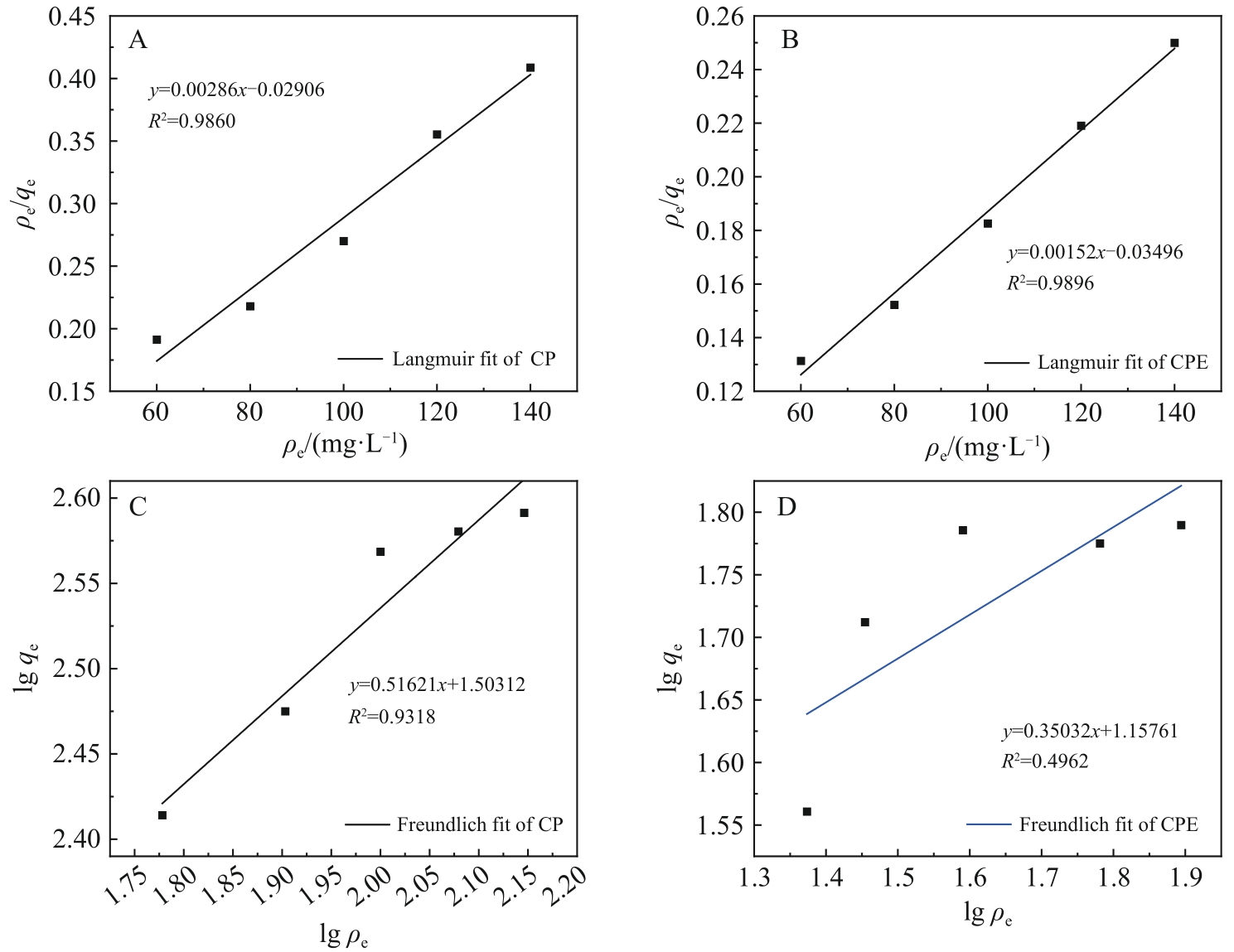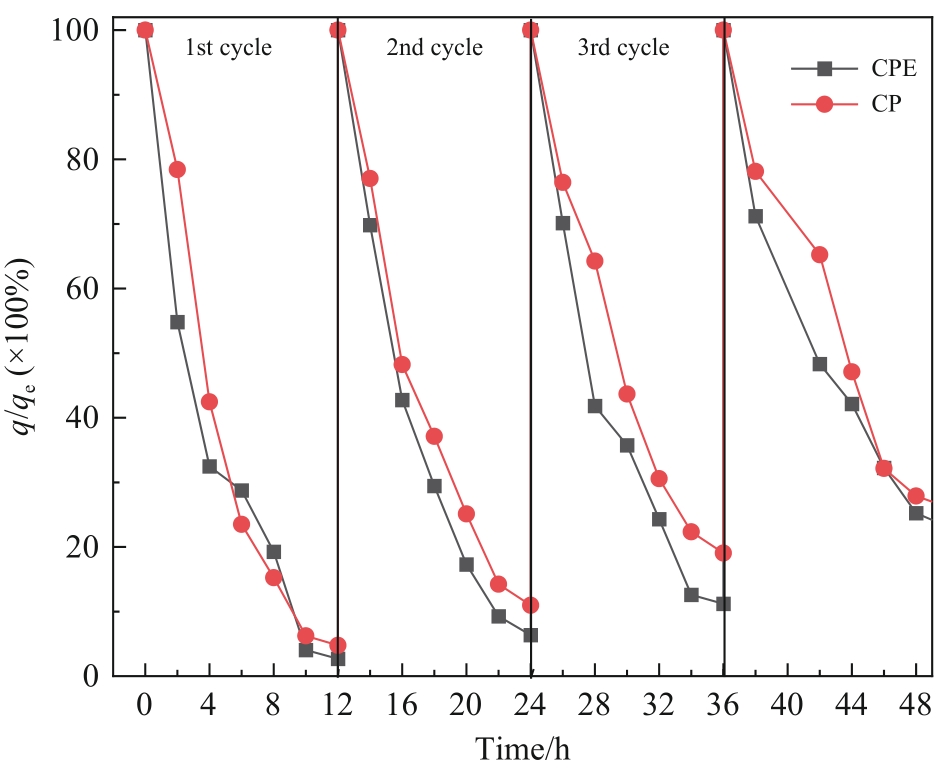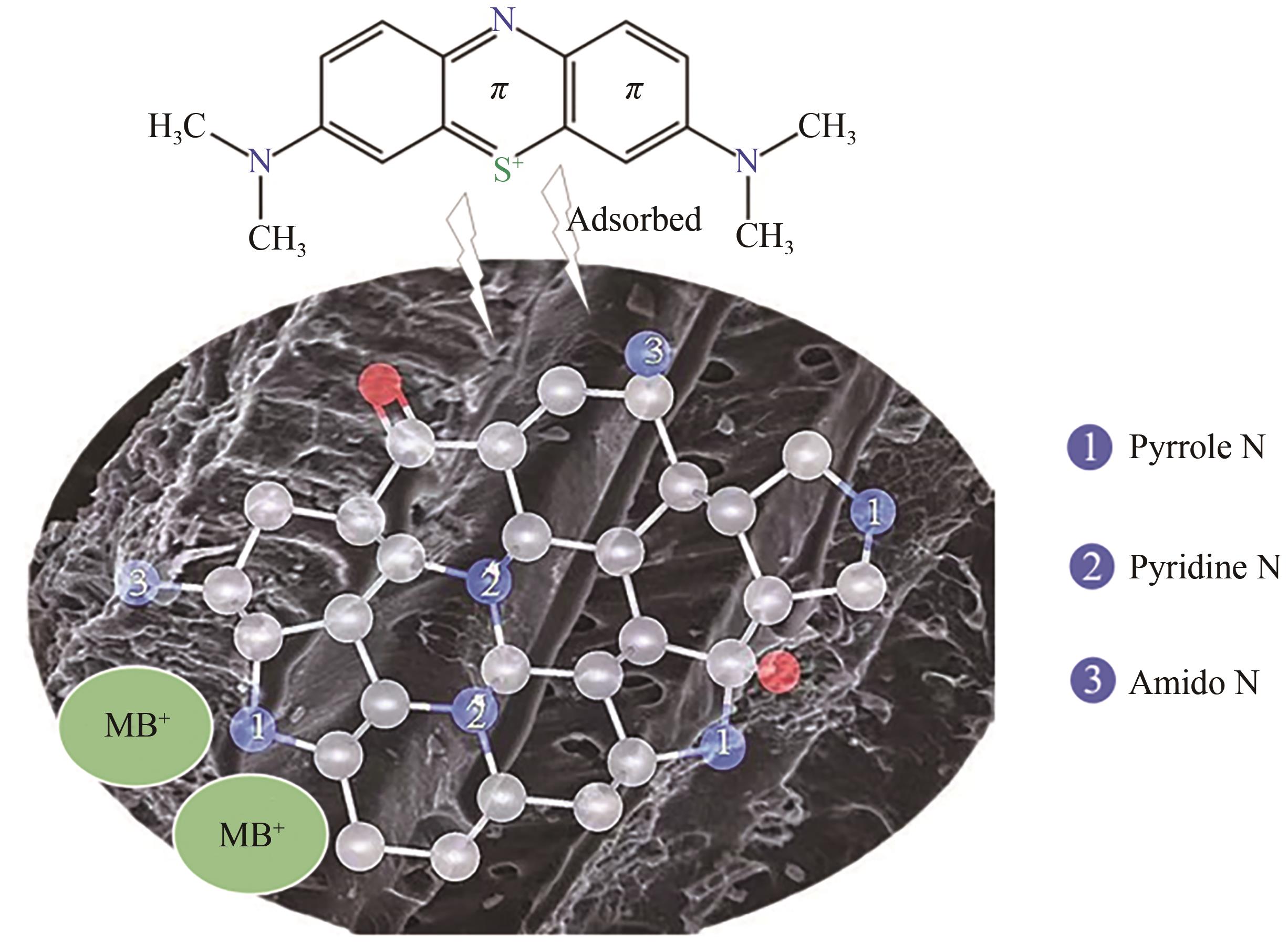
应用化学 ›› 2024, Vol. 41 ›› Issue (7): 1035-1046.DOI: 10.19894/j.issn.1000-0518.240041
乙二酸四乙酸二钠盐改性枸杞杆生物炭对亚甲基蓝吸附性能
任艳娇1( ), 徐荣声2, 王萍2, 孙冬2, 耿万东2, 张海永3
), 徐荣声2, 王萍2, 孙冬2, 耿万东2, 张海永3
- 1.宁夏大学新华学院,银川 750021
2.北方民族大学化学与化工学院,银川 750411
3.中国矿业大学(北京)化学与环境工程学院,北京 100083
-
收稿日期:2024-02-04接受日期:2024-05-05出版日期:2024-07-01发布日期:2024-08-03 -
通讯作者:任艳娇 -
基金资助:年宁夏大学新华学院重点科研项目(21XHKY02);2023年宁夏回族自治区高等学校科学研究项目(NYG2024230);2024年宁夏大学新华学院科研项目(24XHKY13)
Methylene Blue Adsorption Properties of Modified Wolfberry Biochar with EDTA-2Na
Yan-Jiao REN1( ), Rong-Sheng XU2, Ping WANG2, Dong SUN2, Wan-Dong GENG2, Hai-Yong ZHANG3
), Rong-Sheng XU2, Ping WANG2, Dong SUN2, Wan-Dong GENG2, Hai-Yong ZHANG3
- 1.Xinhua College of Ningxia University,Yinchuan 750021,China
2.Chemistry and Chemical Engineering College,North Minzu University,Yinchuan 750021,China
3.Chemistry and Environmental Engineering College,China University of Mining and Technology (Beijing),Beijing 100083,China
-
Received:2024-02-04Accepted:2024-05-05Published:2024-07-01Online:2024-08-03 -
Contact:Yan-Jiao REN -
About author:ryj844278352@163.com
-
Supported by:the Key Research Project of Xinhua College of Ningxia University in 2021(21XHKY02);the Scientific Research Project of Higher Education Institutions of Ningxia Hui Autonomous Region in 2023(NYG2024230);the Research Project of Xinhua College of Ningxia University in 2024(24XHKY13)
摘要:
以H3PO4为活化剂,通过高温炭化法将宁夏枸杞杆制备成生物质活性炭(CP),并利用乙二酸四乙酸二钠盐(EDTA-2Na)对其进行表面改性,得到氮掺杂活性炭(CPE)。 利用比表面积分析(BET)、X射线衍射仪(XRD)、X射线光电子能谱分析仪(XPS)、傅里叶变换红外光谱仪(FT-IR)和扫描电子显微镜(SEM)技术手段研究其表面微观形貌和化学结构特性,阐明了EDTA-2Na的改性机理和CPE对亚甲基蓝的吸附机制。 结果表明: EDTA-2Na的掺杂可以有效调控生物炭的孔结构和官能团,显著提升了生物炭的比表面积、孔结构和活性吸附位点。 EDTA-2Na改性后的生物炭CPE(比表面积(816.47 m2/g)、总孔体积(0.4925 cm3/g)和平均孔径(2.41 nm))参数明显优于CP(比表面积(241.45 m2/g)、总孔体积(0.1280 cm3/g)和平均孔径(2.12 nm))的微观结构,表面形成较稳定的氨基(—NH—、—NH2—)和吡咯结构氮,构成了对亚甲基蓝有较好吸附效果的活性表面生物质碳材料CPE。 常温中性条件下,CPE对MB的最大吸附量为658.8 mg/g,较未进行N掺杂的生物碳CP(吸附量为358.2 mg/g)吸附率提升了83.92%。 CPE对MB的等温吸附过程符合Langmuir模型(R2=0.9896),吸附动力学符合准二级动力学模型(R2=0.99997),吸附过程主要以单分子层化学吸附为主,循环使用性能较好。
中图分类号:
引用本文
任艳娇, 徐荣声, 王萍, 孙冬, 耿万东, 张海永. 乙二酸四乙酸二钠盐改性枸杞杆生物炭对亚甲基蓝吸附性能[J]. 应用化学, 2024, 41(7): 1035-1046.
Yan-Jiao REN, Rong-Sheng XU, Ping WANG, Dong SUN, Wan-Dong GENG, Hai-Yong ZHANG. Methylene Blue Adsorption Properties of Modified Wolfberry Biochar with EDTA-2Na[J]. Chinese Journal of Applied Chemistry, 2024, 41(7): 1035-1046.
| Sample | Vmic/(cm3·g-1) | Vmes/(cm3·g-1) | Vtot/(cm3·g-1) | SBET/(cm2·g-1) | Dp/nm |
|---|---|---|---|---|---|
| CP | 0.096 3 | 0.031 8 | 0.128 0 | 241.45 | 2.12 |
| CPE | 0.380 0 | 0.112 6 | 0.492 5 | 816.47 | 2.41 |
表1 活性炭的比表面积和孔结构参数
Table 1 Specific surface area and pore structure parameters of activated carbon
| Sample | Vmic/(cm3·g-1) | Vmes/(cm3·g-1) | Vtot/(cm3·g-1) | SBET/(cm2·g-1) | Dp/nm |
|---|---|---|---|---|---|
| CP | 0.096 3 | 0.031 8 | 0.128 0 | 241.45 | 2.12 |
| CPE | 0.380 0 | 0.112 6 | 0.492 5 | 816.47 | 2.41 |
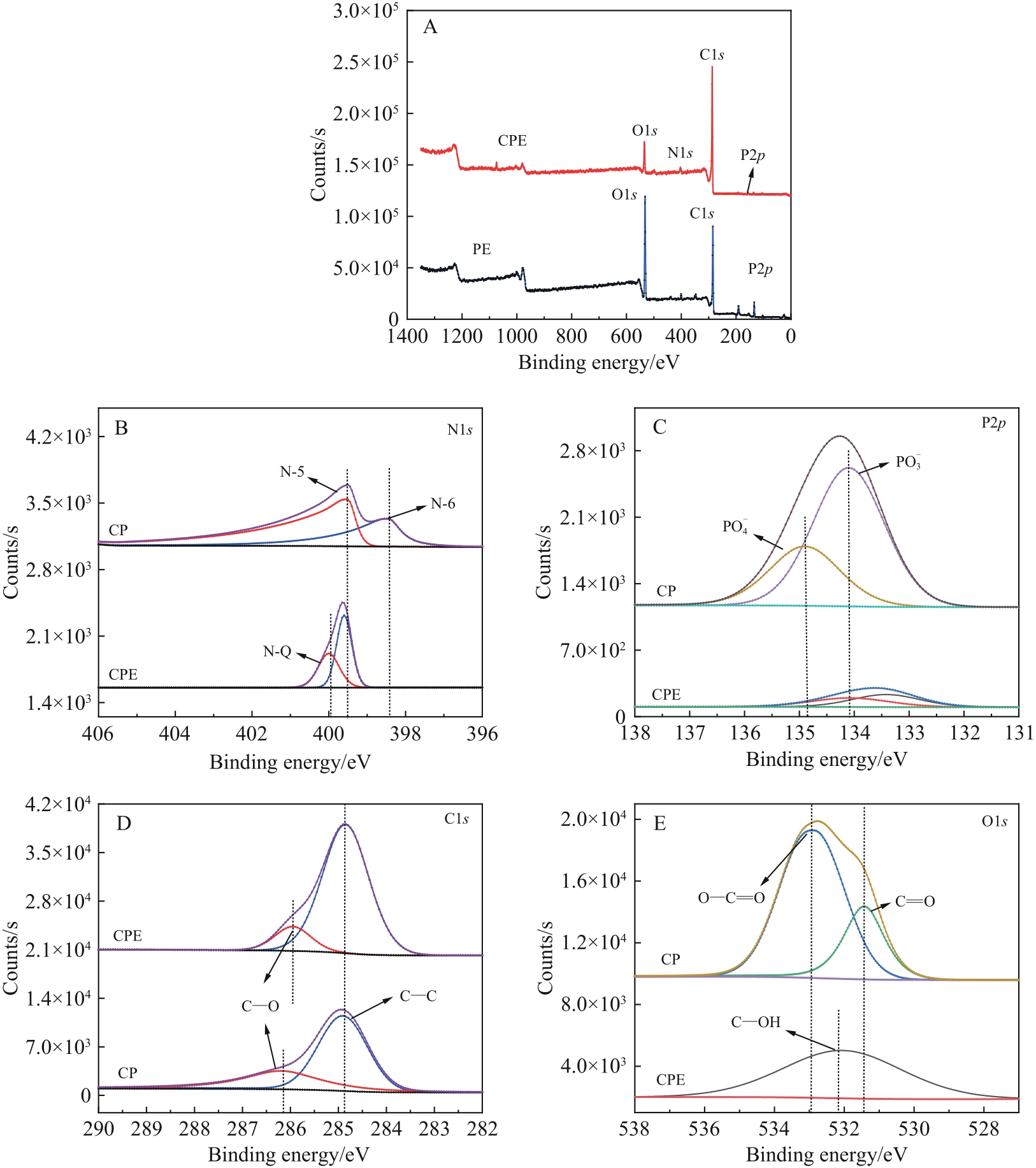
图5 CPE和CP的XPS全谱图(A)、CPE和CP的N1s谱图(B)、P2p谱图(C)、C1s谱图(D)和O1s谱图(E)
Fig.5 XPS full spectra of CPE and CP (A), N1s spectra (B), P2p spectra (C), C1s spectra (D) and O1s spectra (E) of CPE and CP
| Sample | C/% | N/% | O/% | P/% | |
|---|---|---|---|---|---|
| CP | Total percentage/% | 58.76 | 3.14 | 31.14 | 6.96 |
| CPE | 83.71 | 4.59 | 10.61 | 1.09 | |
表2 2种活性炭表面各元素XPS的分析结果
Table 2 Results of XPS analysis of surface elements of two activated carbons
| Sample | C/% | N/% | O/% | P/% | |
|---|---|---|---|---|---|
| CP | Total percentage/% | 58.76 | 3.14 | 31.14 | 6.96 |
| CPE | 83.71 | 4.59 | 10.61 | 1.09 | |
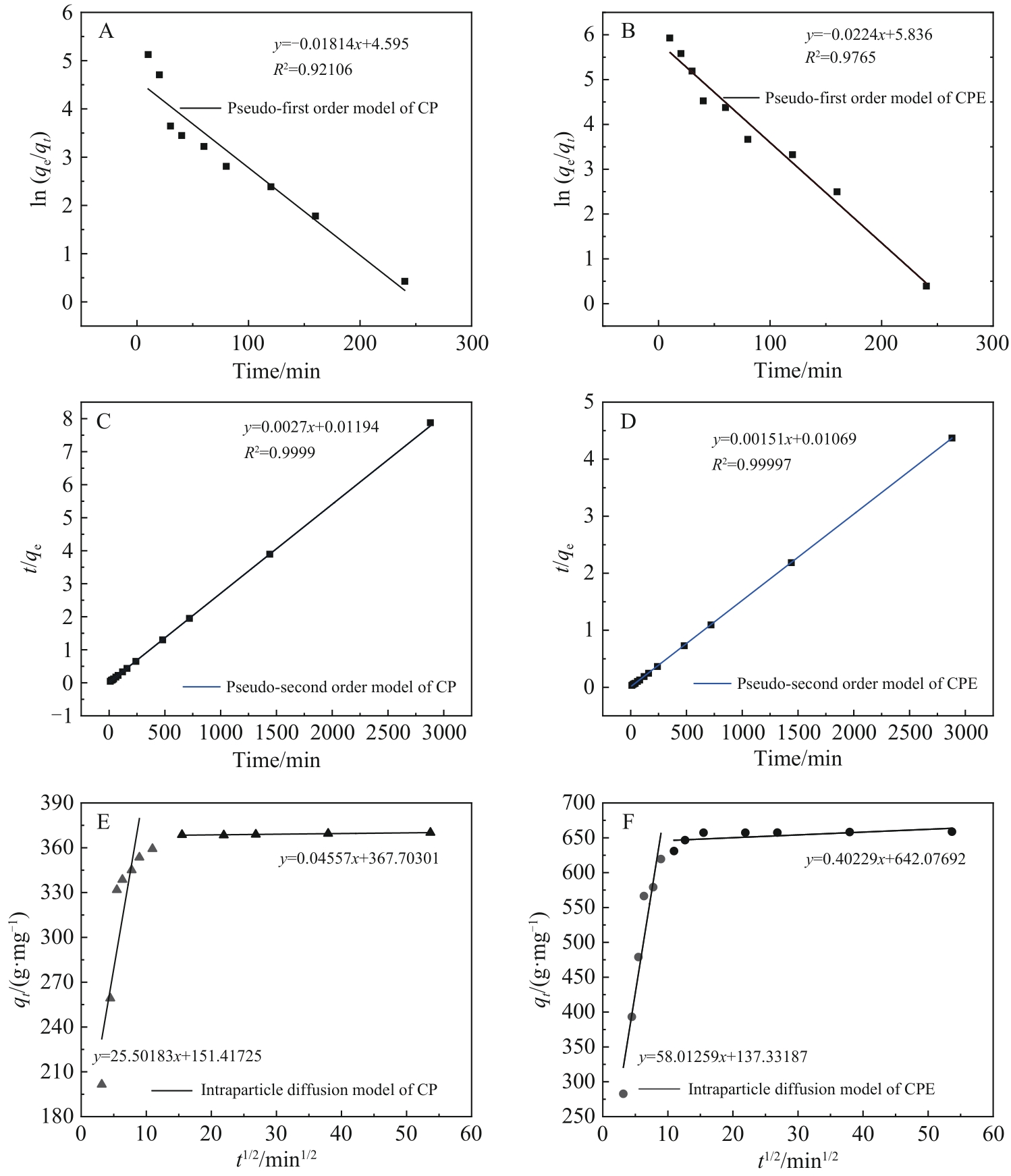
图7 CP (A、C、E)和CPE (B、D、F)对MB准一级动力学模型、准二级动力学模型和颗粒内扩散模型
Fig.7 Quasi-first-order kinetic model, quasi-second-order kinetic model and in-particle diffusion model of CP (A, C, E) and CPE (B, D, F) for MB
| Sample | Pseudo-first order model | Pseudo-second order model | ||||
|---|---|---|---|---|---|---|
| qe/(mg·g-1) | K1/min-1 | R2 | qe/(mg·g-1) | K2/min-1 | R2 | |
| CP | 39.3 | 0.006 1 | 0.921 06 | 370.4 | 0.000 611 | 0.999 9 |
| CPE | 112.3 | 0.008 1 | 0.976 5 | 662.3 | 0.000 213 | 0.999 97 |
| Sample | Intraparticle diffusion model | |||||
| Kid1/(mg·g-1·min-1/2) | C1 | Kid2/(mg·g-1·min-1/2) | C2 | |||
| CP | 25.501 8 | 151.417 3 | 0.838 9 | 0.045 57 | 367.703 0 | 0.932 8 |
| CPE | 58.012 6 | 137.331 9 | 0.955 1 | 0.402 3 | 642.076 9 | 0.601 9 |
表3 3种动力学模型的主要参数
Table 3 Main parameters of the three dynamic models
| Sample | Pseudo-first order model | Pseudo-second order model | ||||
|---|---|---|---|---|---|---|
| qe/(mg·g-1) | K1/min-1 | R2 | qe/(mg·g-1) | K2/min-1 | R2 | |
| CP | 39.3 | 0.006 1 | 0.921 06 | 370.4 | 0.000 611 | 0.999 9 |
| CPE | 112.3 | 0.008 1 | 0.976 5 | 662.3 | 0.000 213 | 0.999 97 |
| Sample | Intraparticle diffusion model | |||||
| Kid1/(mg·g-1·min-1/2) | C1 | Kid2/(mg·g-1·min-1/2) | C2 | |||
| CP | 25.501 8 | 151.417 3 | 0.838 9 | 0.045 57 | 367.703 0 | 0.932 8 |
| CPE | 58.012 6 | 137.331 9 | 0.955 1 | 0.402 3 | 642.076 9 | 0.601 9 |
| Sample | Freundlich | |||||
|---|---|---|---|---|---|---|
| qe/(mg·g-1) | KL/min-1 | R2 | KF( | 1/n | R2 | |
| CP | 349.7 | 0.098 42 | 0.986 0 | 31.850 8 | 0.516 2 | 0.931 8 |
| CPE | 657.9 | 0.043 48 | 0.989 6 | 14.375 1 | 0.350 3 | 0.496 2 |
表4 Langmuir和Freundlich等温吸附模型参数
Table 4 Parameters of Langmuir and Freundlich isothermal adsorption models
| Sample | Freundlich | |||||
|---|---|---|---|---|---|---|
| qe/(mg·g-1) | KL/min-1 | R2 | KF( | 1/n | R2 | |
| CP | 349.7 | 0.098 42 | 0.986 0 | 31.850 8 | 0.516 2 | 0.931 8 |
| CPE | 657.9 | 0.043 48 | 0.989 6 | 14.375 1 | 0.350 3 | 0.496 2 |
| Biomass | Adsorption | Specific surface area/(m2·g-1) | Pass | Nitrogenous species | MB adsorption capacity/(mg·g-1) | Ref. |
|---|---|---|---|---|---|---|
| Peanut shell | K2CO3+Melamine | 1 922.27 | Micropore and mesopore | Quaternary nitrogen, pyridinium oxide nitrogen | 480.5 | [ |
| Corn stalk | KHCO3+Urea | 1 871 | Mesopore | Pyrrole N and pyridine N | 491 | [ |
| Sichuan pepper seed | H3PO4 | 740 | Micropore and mesopore | - | 495 | [ |
| Bamboo | Urea+KHCO3 | 1 693 | Mesopore | Pyridine nitrogen, pyrrole nitrogen and amino nitrogen | 499.3 | [ |
| Wolfberry stalk | H3PO4+EDTA-2Na | 816.47 | Micropore and mesopore | Amido(—NH—, —NH2—) and pyrrole nitrogen | 658.8 | This work |
表5 氮掺杂改性方法与常用生物质活性炭吸附MB效果比较
Table 5 Comparison of nitrogen doping modification methods and MB adsorption effects of common biomass activated carbon
| Biomass | Adsorption | Specific surface area/(m2·g-1) | Pass | Nitrogenous species | MB adsorption capacity/(mg·g-1) | Ref. |
|---|---|---|---|---|---|---|
| Peanut shell | K2CO3+Melamine | 1 922.27 | Micropore and mesopore | Quaternary nitrogen, pyridinium oxide nitrogen | 480.5 | [ |
| Corn stalk | KHCO3+Urea | 1 871 | Mesopore | Pyrrole N and pyridine N | 491 | [ |
| Sichuan pepper seed | H3PO4 | 740 | Micropore and mesopore | - | 495 | [ |
| Bamboo | Urea+KHCO3 | 1 693 | Mesopore | Pyridine nitrogen, pyrrole nitrogen and amino nitrogen | 499.3 | [ |
| Wolfberry stalk | H3PO4+EDTA-2Na | 816.47 | Micropore and mesopore | Amido(—NH—, —NH2—) and pyrrole nitrogen | 658.8 | This work |
| 1 | STEPHHEN E O, OWINO F G, GATHERU M W, et al. Occurrence, formation and environmental fate of polycyclic aromatic hydrocarbons in biochars[J]. Fundam Res, 2021, 1(3): 296-305. |
| 2 | YU L H. Construction of resource utilization engineering mode for agricultural residues[J]. Trans Agric Eng, 2013, 29(11): 210-216. |
| 3 | DAI Z Y, ZHOU J L, LIU W Y, et al. Effect of K+ modified biochar on methylene blue adsorption properties[J]. J China Coal Soc, 2023, 48(6): 2419-2430. |
| 4 | DAO M U, LE H S, HOANG H Y, et al. Natural core-shell structure activated carbon beads derived from Litsea glutinosa seeds for removal of methylene blue: facile preparation, characterization, and adsorption properties[J]. Technol Res, 2020, 198: 110481-110491. |
| 5 | 王子琦. 生物质基氮掺杂碳材料制备方法及亚甲基蓝吸附性能研究[D]. 合肥: 合肥工业大学, 2022. |
| WANG Z Q. Study on preparation method and methylene blue adsorption performance of biomas-based nitrogen-doped carbon materials[D]. Hefei: Hefei University of Technology, 2022. | |
| 6 | LIU F, ZHAO J, WANG S, et al. Adsorption of sulfonamides on reduced graphene oxides as affected by pH and dissolved organic matter[J]. Environ Pollut, 2016, 210: 171-178. |
| 7 | PARK J H, WANG J J, MENG Y, et al. Adsorption/desorption behavior of cationic and anionic dyes by biochars prepared at normal and high pyrolysis temperatures[J] .Colloids Surf Phys Chem Eng Aspects, 2019, 572: 274-282. |
| 8 | 徐荣声, 冯倩, 孟泽, 等. 枸杞杆制活性炭对亚甲基蓝的吸附研究[J]. 无机盐工业, 2022, 54(12): 106-112. |
| XU R S, FENG Q, MENG Z, et al. Study on methylene blue adsorption by activated carbon from Wolfberry rod[J]. Inorg Chem Ind, 2022, 54(12): 106-112. | |
| 9 | 汪辉春, 王莹, 顾明言, 等. 金属氧化物与掺氮生物质协同吸附CO2机理[J]. 洁净煤技术, 2023, 29(10): 98-107. |
| WANG H C, WANG Y, GU M Y, et al. Mechanism of CO2 adsorption by metal oxides and nitrogen-doped biomass[J]. Clean Coal Technol, 2023, 29(10): 98-107. | |
| 10 | HAN Z, RONG H L, ZENG Q Z. A versatile EDTA and chitosan bi-functionalized magnetic bamboo biochar for simultaneous removal of methyl orange and heavy metals from complex wastewater[J]. Environ Pollut, 2022, 293: 118517-118532. |
| 11 | BELHAMDI B, MERZOUGUI Z, LAKSACI H, et al. The removal and adsorption mechanisms of free amino acid l-tryptophan from aqueous solution by biomass-based activated carbon by H3PO4 activation: regeneration study[J]. Phys Chem Earth, 2019, 114: 102791-102813. |
| 12 | HE C, HU X J. Anionic dye adsorption on chemically modified ordered mesoporous carbons[J]. Ind Eng Chem Res, 2011, 50(24): 14070⁃14083 |
| 13 | OH T, KIM M, PARK D, et al. Synergistic interaction and controllable active sites of nitrogen and sulfur Co⁃doping into mesoporouscarbon sphere for high performance oxygen reduction electrocata⁃lysts[J]. Appl Surf Sci, 2018, 440: 627⁃636 |
| 14 | XU R S, FENG Q, MENG Z, et al. Study on methylene blue adsorption by activated carbon from Wolfberry rod[J]. Inorg Salts Ind, 2022, 54(12): 106-112. |
| 15 | MA P Y, WU J Z, ZHANG X W, et al. Preparation of activated carbon by dry mixing of K2CO3-sawdust[J]. Chin J Process Eng, 2018, 18(1): 159-164. |
| 16 | ZHAO J B, ZHU J B, ZHUANG C F, et al. Removal performance and mechanism of lead and cadmium in water by cornstraw biochar[J]. Biomass Chem Eng, 2022, 56(4): 15-24. |
| 17 | 冯倩, 徐荣声, 李梅, 等. 向日葵制活性炭对亚甲基蓝的吸附研究[J]. 无机盐工业, 2021, 53(12): 122-128. |
| FENG Q, XU R S, LI M, et al. Study on methylene blue adsorption by activated carbon from sunflower[J]. Inorg Chem Ind, 2021, 53(12): 122-128. | |
| 18 | 吕松磊. 稻壳基活性炭的制备、改性以及对苯酚的吸附机理研究[D]. 北京:北京化工大学, 2021. |
| LU S L. Preparation, modification and adsorption mechanism of rice husk based activated carbon[D]. Beijing: Beijing University of Chemisty Technology, 2021. | |
| 19 | 谢蕾. 热活化氮掺杂改性活性炭吸附金-硫代硫酸根络离子[D]. 武汉: 武汉工程大学, 2023. |
| XIE L. Adsorption of au-thiosulfate complex ions by thermal activated nitrogen-doped activated carbon[D]. Wuhan: Wuhan Institute of Technology, 2023. | |
| 20 | HADOUN H, SADAOUI Z, SOUAMI N, et al. Characterization of mesoporous carbon prepared from date stems by H3PO4 chem activation[J]. Appl Surf Sci, 2013, 280: 1-7. |
| 21 | ZHU Y, MURALI S, STOLLER M D, et al. Carbon-based supercapacitors produced by activation of graphene[J]. Science, 2011, 332(6037): 1537-1541. |
| 22 | YU D X, XUAN D, WEI Q C, et al. Ramie biomass derived nitrogen-doped activated carbon for efficient electrocatalytic production of hydrogen peroxide[J]. J Electrochem Soc, 2018, 165(5): 1367-1379. |
| 23 | YU S, JUN M, SATOSHI I, et al. Nitrogen-doped biomass/polymer composite porous carbons for high performance supercapacitor[J]. J Power Sources, 2017, 364: 374-382. |
| 24 | 苗树伟, 傅培舫, 刘洋, 等. 褐煤热解过程中含氧官能团的演化[J]. 热力发电, 2018, 47(8): 16-21. |
| MIAO S W, FU P F, LIU Y, et al. Evolution of oxygen-containing functional groups during the pyrolysis of lignite[J]. Therm Power Gen, 2018, 47(8): 16-21. | |
| 25 | 孙兆勇. 石墨烯与复合物的制备以及铀吸附性能研究[D]. 哈尔滨: 哈尔滨工程大学, 2013. |
| SUN Z Y. Preparation of graphene and composites and Study on adsorption properties of uranium[D]. Harbin: Harbin Institute of Technology, 2013. | |
| 26 | YANG T, LI K, LIU Z, et al. One-step synthesis of hydrangea-like Cu2O@N-doped activated carbon as air cathode catalyst in microbial fuel cell[J]. J Electrochem Soc, 2017, 164(4): 270-275. |
| 27 | SINGH C V. Removal of reactive orange 16 by adsorption onto activated carbon prepared from rice husk ash: statistical modelling and adsorption kinetics[J]. Sep Sci Technol, 2020, 55(1): 26-34. |
| 28 | LIU Z, ZHANG J, ZHANG L, et al. Efficient removal of Congo red and methylene blue using biochar from Medulla Tetrapanacis modified by potassium carbonate[J]. Bioresour Technol, 2023, 376: 128912-128925. |
| 29 | 王萍, 徐荣声, 孙冬, 等. 氮掺杂生物炭的制备及其对亚甲基蓝的吸附性能研究[J/OL]. 无机盐工业, 2024, 5(3): 1-17. |
| WANG P, XU R S, SUN D, et al. Preparation of nitrogen-doped biochar and its adsorption properties for methylene blue[J/OL]. Inorg Salt Ind, 2024, 5(3): 1-17. | |
| 30 | 尤智丛. 花生壳基生物炭的制备及对亚甲基蓝吸附性能研究[D]. 北京: 中国矿业大学(北京), 2023. |
| YOU Z C. Study on preparation and methylene blue adsorption properties of peanut shell-based biochar[D]. Beijing: China University of Mining and Technol-Beijing, 2023. | |
| 31 | KALPANA P, MANISH V. Activated carbon from mustard stalk biomass: synthesis, characterization and application in wastewater treatment[J]. J Serb Chem Soc, 2021, 86(4): 429-444. |
| 32 | LEMYA B, FAROUK Z, M'HAMED G, et al. New alginic acid derivatives ester for methylene blue dye adsorption: kinetic, isotherm, thermodynamic, and mechanism study[J]. Int J Biol Macromol, 2022: 205651-205663. |
| 33 | LI Z, XING B, DING Y, et al. A high-performance biochar produced from bamboo pyrolysis with in-situ nitrogen doping and activation for adsorption of phenol and methylene blue[J]. Chin J Chem Eng, 2020, 28(11): 2872-2880. |
| 34 | 严梦娟. 竹基多孔吸附材料的研制及其对染料废水的净化研究[D]. 桂林: 广西师范大学, 2023. |
| YAN M J. Preparation of bamboo based polyporous adsorbent and its purification of dye wastewater[D]. Guilin: Guangxi Normal University, 2023. |
| [1] | 赛徐煦, 胡晓丽, 孙利民, 刘洪基, 陈洲, 方维平, 伊晓东. Zn改性Ni/Al2O3催化剂的苯乙炔选择加氢性能[J]. 应用化学, 2024, 41(7): 948-958. |
| [2] | 陆志艳, 陈雯轩, 孙汪师诒, 卓宁泽, 魏潇, 廖丽芳, 许庆利, 吴诗勇. Ce-Mn/ZrO2复合催化剂的制备及其固硫性能[J]. 应用化学, 2024, 41(6): 839-850. |
| [3] | 万冰洁, 刘小雪, 齐林光, 贾长超, 刘健. TiO2基光催化CO2还原研究进展[J]. 应用化学, 2024, 41(5): 637-658. |
| [4] | 王眉花, 冯禹, 王运坤, 赵旭东, 杨雯, 董川. 原子层沉积法制备限域型Pt基催化剂及其苯酚催化性能[J]. 应用化学, 2024, 41(4): 547-556. |
| [5] | 彭秀英, 高小艳, 王松柏, 刘福. 掺杂型三维多孔纳米镍催化偶氮染料脱色性能[J]. 应用化学, 2024, 41(4): 557-567. |
| [6] | 商宗玲, 张弨, 赵凤玉. 稀土修饰对Cu/Al2O3催化乙酰丙酸乙酯加氢性能的影响[J]. 应用化学, 2024, 41(3): 340-348. |
| [7] | 王鹏. 《环境功能材料》专辑序言——环境功能材料在生态环境中的作用机遇与前沿动态[J]. 应用化学, 2024, 41(2): 175-176. |
| [8] | 孙天礼, 朱国, 何海, 黄炳坤, 熊兆锟, 赖波. 单原子催化剂在类芬顿水处理领域的研究进展[J]. 应用化学, 2024, 41(2): 217-229. |
| [9] | 沈天瑶, 杨怿, 于海鹤, 徐鹏, 张广山, 王鹏. CoFe-LDH/泡沫铜的制备及催化介质阻挡放电等离子体降解水中敌草隆性能与机制[J]. 应用化学, 2024, 41(2): 243-255. |
| [10] | 曹梦寒, 徐鹏, 石凤银, 李桂鄂, 张国栋, 郑庆柱, 张广山. CoFe2O4/MXene复合材料的构筑及活化过氧单硫酸盐降解阿特拉津[J]. 应用化学, 2024, 41(2): 256-267. |
| [11] | 张涛, 张贺, 杜雅欣, 展思辉. Co掺杂Mn2O3复合材料的构筑及活化过氧单硫酸盐降解医药废水[J]. 应用化学, 2024, 41(2): 268-278. |
| [12] | 张涛, 李思莹, 李俊乐, 邵思羽, 吴传栋, 凌梅, 吕东伟, 王威. 颗粒状碳酸氧镧去除水体中氟的性能[J]. 应用化学, 2024, 41(2): 297-307. |
| [13] | 秦君, 张瑜, 辛智慧, 李小梅, 张潇, 闫亭璇, 冯锋, 白云峰. CuMn2O4@GA复合材料的合成与CO转化[J]. 应用化学, 2023, 40(12): 1719-1725. |
| [14] | 陈淑敏, 吕子全, 邹旋, 桂水清, 卢雪梅. 新冠常态下功能性口罩研究进展[J]. 应用化学, 2023, 40(11): 1504-1517. |
| [15] | 孟君玲, 田川, 徐娜, 赵丽娜, 钟海霞, 徐占林. 固体氧化物燃料电池电极表面原位析出的研究进展[J]. 应用化学, 2023, 40(10): 1335-1346. |
| 阅读次数 | ||||||
|
全文 |
|
|||||
|
摘要 |
|
|||||
